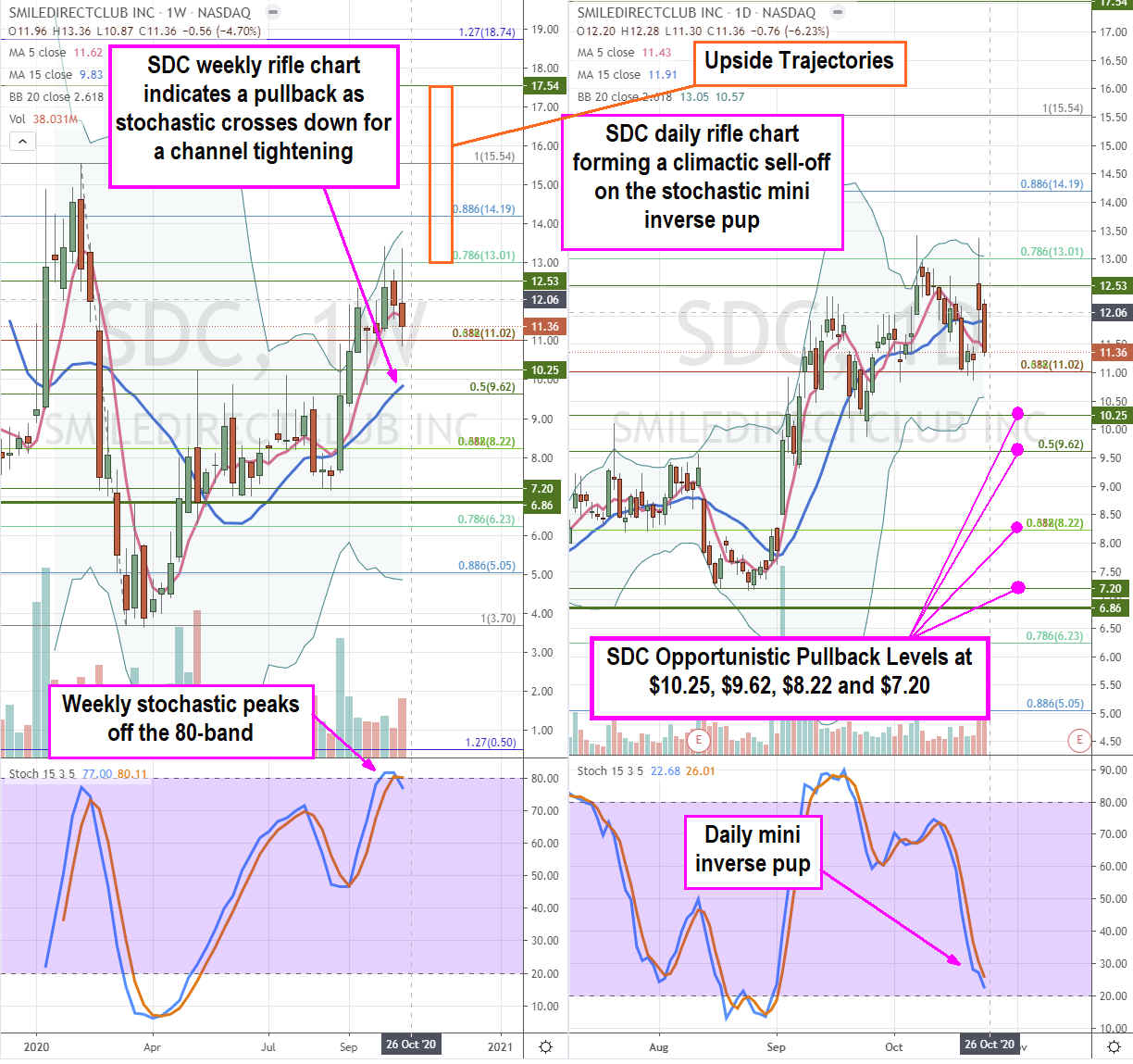
Dental products company
SmileDirectClub, Inc. (NASDAQ: SDC) stock is still trading below its pre-COVID and IPO price levels heading into Q3 earnings. Shares are still underperforming the benchmark
S&P 500 index (NYSEARCA: SPY) and trading well under its $20.55 IPO opening price from September 2019. The Company sells teeth alignment products and provides a teledentistry platform for users to connect with dentists to help navigate through the treatment period. The virtually “no contact” element of the products is both convenient and economical especially in the backdrop of avoiding the spread of COVID-19. Shares have been a bit of a rollercoaster during the pandemic plunge but with the
recent blowout results from competitor
Align Technologies (NASDAQ: ALGN), makers of Invisalign, SmileDirectClub may have a high bar to leap over. Prudent investors seeking to get in on this undervalued dual narrative dental play can watch for opportunistic pullback levels for exposure.
Q2 FY 2020 Earnings Release
On Aug. 12, 2020, SmileDirectClub released its fiscal second-quarter 2020 results for the quarter ending June 2020. The Company reported an earnings-per-share (EPS) loss of (-$0.13) excluding non-recurring items in-line with consensus analyst estimates. Revenues collapsed (-45.3%) year-over-year (YoY) to $107.7 million buy still beating the consensus analyst estimates of $84.19 million. The Company closed the quarter with $389 million in cash and cash equivalents. Investor sentiment plunged as shares fell over (-25%) in the following days.
Conference Call Takeaways
SmileDirectClub CEO, David Katzman, reiterated the Company as a telehealth business. The pandemic has accelerated the acceptance of telemedicine out of necessity. This trend bodes well for the teledentistry platform that is core to the business. The Company shipped 57,000 unique aligner orders as an average sale price (ASP) of $1,817, generating $107 million in total revenues. The SmilePay program didn’t see any abnormal delinquency issues with only 2% of customers requesting payment deferrals. Almost 67% of members elected to use SmilePay financing on purchases. Marketing and selling expenses fell to 32% of net revenues, down from 72% in Q4 2019. Katzman credits this to the investment in positive customer experience and brand building from its “highly efficient acquisition” channel. Demand is driven by the website and enabled through the teledentistry platform. The Company expanded its customer acquisition model from dentists to corporate partnerships like Allianz. Insurance network expansion in the quarter included inclusion into the Anthem Blue Cross and Blue Shield and Empire Blue Cross and Blue Shield insurance programs. Oral care products debuted in Walmart (NYSE: WMT) in January 2020 to raise brand awareness. The consumer products are also available through 3,000 CVS Health (NYSE: CVS) locations in the U.S.
Accelerating Expansion
Its Smile Brands new partnership with 450 dentist offices across 18 states underscores the strategy to partner with general practitioners and orthodontists. The Company has 71 Smile shops open across 57 cities in eight countries. These locations serve as fulfillment centers not sources of demand generation. Smile shops are planned to be set up inside of dental offices as well as CVS Health and Walgreens (NYSE: WBA) locations. Pop up Smile Bus events are planned in areas without Smile shops and at dental practices to accelerate conversions. The Company is also targeting teens with SmileDirectClub Teen as they represent nearly 75% of the market but only 10% of the Company’s penetration. Katzman proclaims that 35% of market opportunity is international. The Company launched its products in Singapore and Austria in the quarter. A new partnership with Watson’s, Asia’s leading beauty and health retailer, which will introduce the Smile shop concept to potentially over 78,000 stores in 13 Asian and European markets. The Company didn’t provide forecasts due to COVID-19 uncertainty, but does expect 83,000 to 87,000 initial aligner orders, which is “consistent with demand over the past 30 days.”
Insider Spike and Peer Drop
On Sept. 2, 2020, a Form-4 filing indicates CEO Katzman acquired 1.28 million shares of stock between $7.63 to $8.25 in the open market. This launched shares backup through pre-earnings price levels. On Oct. 21, 2020, Align Technologies reported a massive Q3 2020 EPS blowout of $2.25 nearly tripling consensus analyst estimates at $0.73. ALGN shares skyrocketed over 25% on the results and pulled up SDC shares on the gap only to sell-off again. Prudent investors should watch for deeper opportunistic pullbacks for exposure.

SDC Opportunistic Pullback Levels
Using the rifle charts on the weekly and daily frames provides a clearer view of the landscape for SDC stock. The weekly rifle chart completed a full stochastic oscillation to peak at the 80-band as it tries to defend the 5-period moving average (MA) support at $11.62 as shares try to hold the $11.02 Fibonacci (fib) level. The weekly rifle chart triggered the market structure low (MSL) when it broke out through $6.86. The daily stochastic triggered a mini inverse pup lean when shares gapped up to $13.40s on ALGN earnings reaction only to get slammed back down through the daily 5-period MA at $11.43. This sets up a potential climactic daily stochastic lean through the 20-bands towards the daily lower Bollinger Bands (BBs) near $10.57. Prudent investors can watch for opportunistic pullback levels at the $10.25 fib, $9.62 fib, $8.22 fib and the $7.20 fib. Lower prices equate to a lower “bar” being set heading into the Q3 earnings due in mid-November.
Companies in This Article: